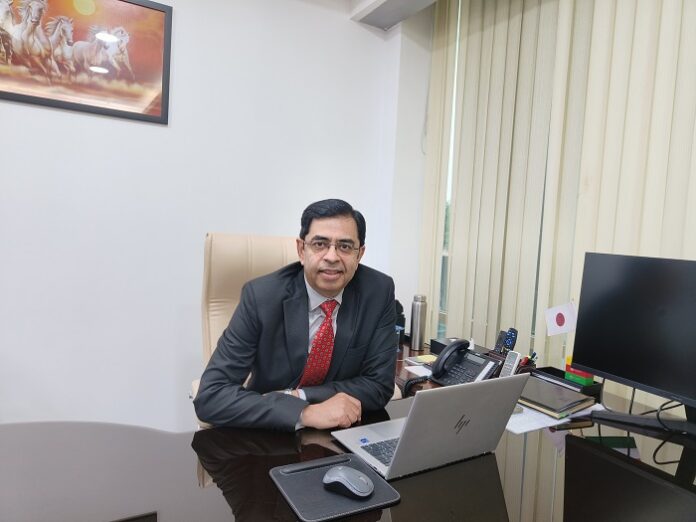Liquid inks for flexible packaging account for the majority of inks major Sakata Inx’ total production with plants in Bhiwadi in Rajasthan and Panoli in Gujarat. Packaging South Asia’s Priyanka Tanwar recently had a conversation with Sakata India’s managing director Yogesh Kapur about the Indian flexible packaging inks market, paperization, participation in Elite Plus, sustainability initiatives, and more.
On Sakata’s role in the Indian flexible packaging inks market
Sakata India, since its inception, has led the Indian flexible packaging inks market with an emphasis on customer-centricity and Japanese global innovation-led growth, Kapur said, adding that with two ink manufacturing facilities in India and local R&D capabilities, Sakata is well-positioned for continued growth in the segment.
Sakata’s high-quality and sustainable inks are positioned well to support rising consumer demand for the packaged goods industry, which is projected to grow with a CAGR of 11%, Kapur said. The adoption of eco-friendly, regulation-compliant products will drive future growth. “The market will not only see continued demand, but also intensified competition and pressure to innovate,” he added.
According to Kapur, Sakata is one of the few ink manufacturing companies in India with a wide range of ink products complying with environmental regulations, including stricter standards prohibiting harmful chemicals such as Toluene and Ketones, energy-curable and water-based inks, with local modern manufacturing facilities and technical support service. “Sakata’s strategic focus on sustainability, compliance, and a blend of global technology with highly skilled local management supports its position for future success,” he elaborated.
Premium and specialty inks will fuel growth and demand as brand owners emphasize high-quality printing for product differentiation and customer shelf appeal, he said, adding that Sakata differentiates itself from competitors by being “economical and lowest in the overall printing costs” solutions rather than just being a low-cost supplier per kilogram.
The push for sustainable inks requires high investment in R&D, advanced manufacturing and stringent quality control, noted Kapur. Sakata is effectively balancing all these, considering the highly cost-sensitive nature of the Indian market, by developing products that meet customer requirements at competitive prices per unit of print.
Flexo vs gravure printing
There is increasing traction for both flexographic and gravure printing in the flexible packaging market, he said, adding flexo is experiencing a little stronger growth trend due to its advantages in speed, job changeover and compatibility with sustainable inks, making it a cost-effective solution for the market’s high demand for innovative and eco-friendly packaging.
While flexo is catching up to gravure in terms of quality for many applications, gravure remains dominant for ultra-high-volume, long-run jobs where its high-quality, consistent output provides a competitive edge, Kapur explained.
“The market is not a zero-sum game, but rather a complex ecosystem where each technology continues to grow and innovate to meet evolving industry needs, particularly concerning quality, sustainability, speed, printing substrate versatility and print cost efficiency,” he added.
Paperization
The increased use of paper in flexible packaging is becoming more visible globally, Kapur said, adding the trend is being strongly driven by consumer and regulatory demand for sustainable alternatives to plastic, leading to advancements in barrier coatings and composite materials to meet product protection needs for foods and other goods.
This shift, known as ‘paperization,’ will accelerate innovation, requiring significant investment in new technologies and infrastructure, and potentially altering production costs, while boosting the market for paper-based solutions and promoting circular economy principles, he said.
The increased use of paper in flexible packaging would have to be supported by deinking technology, which improves the quality of recycled materials, reducing the need for virgin materials and minimizing waste, Kapur cautioned. Paperization, he said, will significantly contribute to lowering carbon footprint and reducing energy consumption in manufacturing. “There will be a greater need for investment in specialized equipment and recycling infrastructure to handle the increased volume of paper-based packaging and ensure its effective recyclability,” he added.
Key challenges
In Kapur’s opinion, India’s flexible packaging industry is on a growth trajectory with rural demand outpacing urban demand. “Key issues include the high cost of equipment and materials, significant challenges with raw material sustainability and recycling due to multi-layer compositions, meeting increasingly stringent safety regulations and environmental norms, fluctuations in raw material supply and prices, and maintaining high print quality and brand consistency on packaging,” he said.
Consumer demand for convenience presents a challenge by requiring innovative packaging design that protects the product and brand while being easy for the consumer to use, he said.
The flexible packaging industry has been sensitive to these issues and is quickly moving toward sustainable, environmentally-friendly and innovative packaging designs while maintaining high-quality print to preserve brand visibility, lower GHG emissions and water usage, Kapur said, adding that with the good monsoon forecast, it’s expected that the flexible packaging industry, led by FMCG, will see growth in Q3 and Q4 of FY 2025-26 in both urban and rural areas.
New products
Kapur told Packaging South Asia that in the next year, Sakata India will likely expand its offerings in advanced, sustainable flexible packaging inks, with a focus on non-toluene, non-ketone (NTNK) inks, nitro-cellulose (NC)-free, PVC-free inks, and water-based inks, alongside new gas barrier and moisture barrier coatings to improve product shelf-life.
The company plans to leverage its expertise in energy-curable inks, including electron beam (EB) curing systems, low migration UV Inks, LED inks to meet the growing demand for eco-friendly solutions.
Sakata India has strengthened its manufacturing base to meet the projected 7-8% growth in the Indian flexible packaging market as well as the export market and to support the installation of new printing presses across assigned markets, including India, MEA, SAARC and others, Kapur said.
“The company will continue to focus on providing strong technical service and support to customers, ensuring that its innovative products offer overall cost savings and high-quality results in production for which we are known,” he added.
Participation in Elite conference
Kapur has been invited to be a part of a panel discussion on ‘Latest Innovations in Raw Material to address future demands’ of flexible packaging at the 12th Speciality Films & Flexible Packaging Global Summit from 3-4 September 2025 at Mumbai’s Jio World Convention Centre.
“I would like to speak about raw material innovations by Sakata Japan and India to meet the growing demands of customers and consumers for eco-friendly and sustainable inks, which use raw materials derived from renewable sources instead of fossil fuels. This could include talking about our new-age products such as Botanical Inks (major RM used is derived from vegetable sources – BelleFlora), NTNK – PVC-free, NC-free inks (Bellecolor VF), NTNK PVC-free inks (LSG NT / XGL 415), low migration UV Inks (INXFLEX), and other sustainable solutions,” he said.
Price pressure in the inks industry
There is healthy price pressure in the flexible packaging inks industry, which motivates Sakata to continuously innovate and come out with innovative value-added products and/or find alternative raw materials for the current and future needs of customers, Kapur said.
“Like any other industry, the inks industry is subject to price pressure from rising raw material costs, particularly from petroleum products and pigments and regulatory compliance requirements. Sakata India is continuously working with our global team to mitigate pricing risks,” he added.












